Wax is a critical component of candle making, as it determines the appearance, burn time, and scent throw of the finished product. However, with so many different types of wax available, it can be challenging to know which one to choose for your candle-making projects. In this post, we’ll explore the most popular types of wax used in candle making and help you determine which one is right for your project.
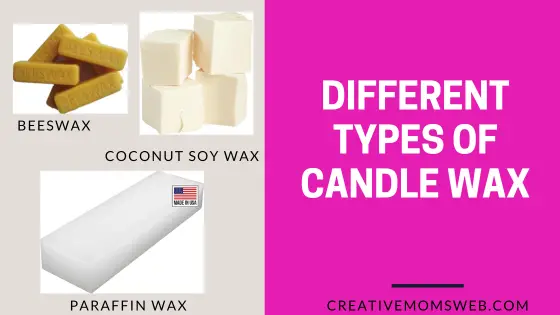
Different types of wax used in candle making project
1. Paraffin Wax
Paraffin wax is the most commonly used wax in candle making, as it is affordable, easy to work with, and widely available. It is a petroleum-based wax that is known for its excellent scent throw and smooth, shiny appearance.
Paraffin wax is available in a variety of melting points, which makes it suitable for a range of different candle types.
However, it is important to note that paraffin wax is not a natural wax and may not be suitable for those who prefer eco-friendly candle-making materials.
Popular paraffin wax for candle-making
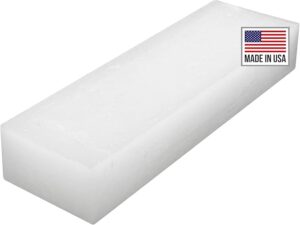
2. Soy Wax
Soy wax is a natural wax made from soybean oil and is a popular choice for eco-conscious candle makers. It is renewable, biodegradable, and produces a clean burn with a subtle scent throw.
Soy wax is available in different melting points and can be used to create a variety of different candle types, including container candles, pillar candles, and tea lights.
However, it is important to note that soy wax can be more expensive than other types of wax, and may not have as strong a scent throw as some other waxes.
Popular soy wax in the market include
American Soy Organics Millennium Wax
American Soy Organics is a good choice for those who want a more eco-friendly option, and it has a low melting point for a good scent throw.
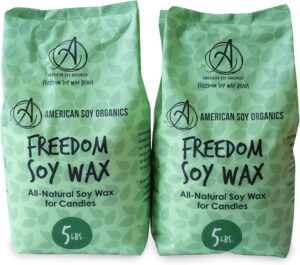
3. Beeswax
Beeswax is a natural wax produced by honeybees and is known for its sweet, honey-like aroma. It is a popular choice for those who prefer natural and sustainable candle-making materials.
Beeswax is a hard wax that is ideal for making pillars and votive candles.
Popular options for high-quality beeswax for candle-making
Some popular options for high-quality beeswax for candle-making include:
White Beeswax Pellets by Sky Organics:
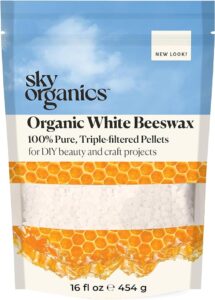
This beeswax is 100% pure, organic, and unbleached, making it a great option for eco-conscious candlemakers.
Yellow Beeswax Blocks by The Stakitch:
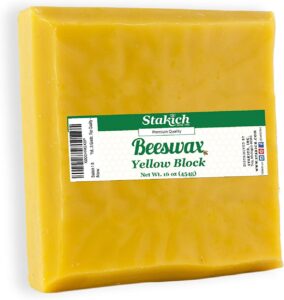
This beeswax is sourced from ethical and sustainable beekeepers and is available in a variety of sizes.
Beeswax Pastilles by Better Shea Butter:
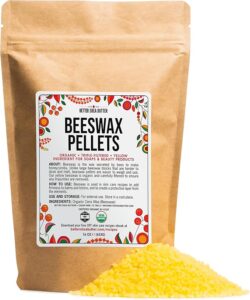
This beeswax is 100% pure, cosmetic grade, and comes in easy-to-use pastilles that melt quickly and evenly.
It is important to note that beeswax is more expensive than other types of wax and may require additional additives to achieve a smooth finish.
4. Palm Wax
Palm wax is a natural wax made from palm oil and is another eco-friendly option for candle makers. It produces a beautiful crystalline finish and has a unique texture that can add interest to candles.
Palm wax is ideal for making container candles and votives, but may not be suitable for pillar candles.
However, it is important to note that palm wax is often associated with environmental concerns, and it is essential to source palm wax from sustainable and responsible sources.
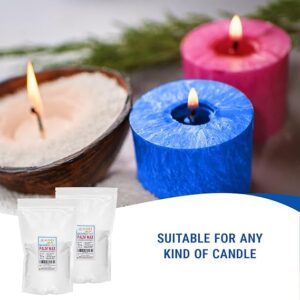
This palm wax can be used to make many types of candles, including pillars, votives, tapers, and tealights. It can be heated to 180 °F (82 °C). You may choose any fragrance for your candle or leave it unscented. The best ratio for scents and colorants are
- Add 0.5 – 1 oz of scents per 1 lb of palm wax
- Add a colorant and up to 0.5 oz of any fragrance or essential oil
5. Coconut wax
Coconut wax is another type of natural wax that has gained popularity among candle makers in recent years.
It is made from the meat of coconuts and is considered an eco-friendly option as it is a renewable resource.
Coconut wax has a low melting point and produces a creamy, white appearance that is ideal for creating container candles.
It also has a strong scent throw and burns cleanly, making it a popular choice for those who prefer natural and sustainable candle-making materials.
However, it is important to note that coconut wax can be more expensive than other types of wax and may require additional additives to achieve the desired consistency and texture.
Additionally, sourcing coconut wax from sustainable and responsible sources is crucial to ensure that the production of this wax does not contribute to environmental harm or exploitation.
Overall, coconut wax is a versatile and eco-friendly option for candle makers looking to experiment with different types of wax.
Popular natural coconut wax brands for candle-making
Some popular natural coconut wax brands for candle-making include Fleur de Spa and Generic. It’s important to note that different brands may have slightly different properties, so it’s best to test the wax before making a large batch of candles.
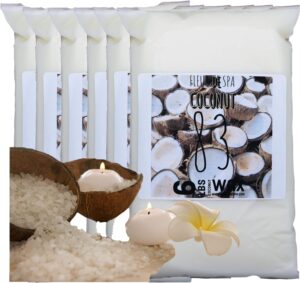
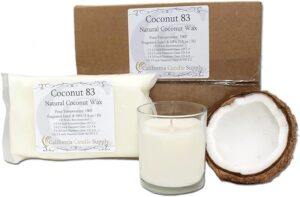
6. Gel Wax
Gel wax is a transparent, jelly-like wax that is ideal for creating unique and decorative candles. It is typically used to make container candles that can incorporate a variety of decorative elements such as seashells, beads, and other small objects. Gel wax can be used on its own or in combination with other waxes to create interesting visual effects. However, it is important to note that gel wax is not suitable for making traditional pillar or taper candles.
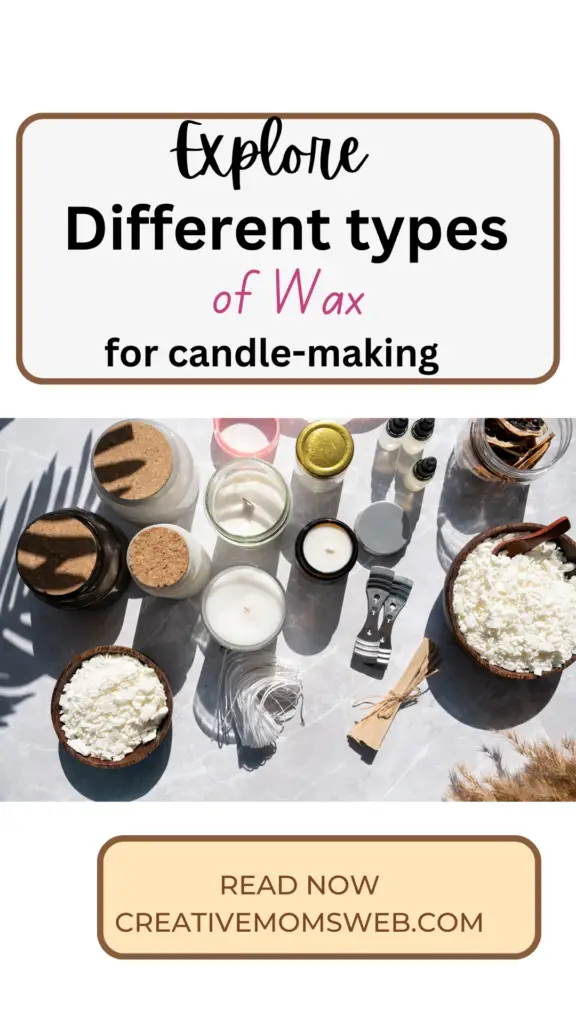
Conclusion
Choosing the right type of wax for your candle-making projects is an essential part of creating beautiful and fragrant candles. By considering factors such as scent throw, burn time, appearance, and eco-friendliness, you can select the wax that best fits your needs and preferences. Whether you choose paraffin, soy, beeswax, palm wax, gel wax, or another type of wax altogether, experimenting with different types of wax can be a fun and rewarding way to expand your candle-making skills and create unique and beautiful candles.
Shop My Favorite Essentials for Candle Making: A Complete Guide for Stay-at-Home Moms
Candle making is a fantastic hobby that allows stay-at-home moms to tap into their creativity, relax, and even start a small business. Whether you’re a beginner or looking to refine your skills, having the right tools and materials is essential. Here’s a list of must-have candle making supplies available on Amazon to get you started. Each item includes a specific product example to make your shopping easier.
1. Wax
Wax is the foundation of any candle. Different types of waxes like soy, beeswax, and paraffin have their unique benefits.
Recommended Product:
- NatureWax C-3 Soy Wax
NatureWax C-3 Soy Wax on Amazon
This all-natural soy wax is perfect for beginners. It provides a smooth finish and excellent scent throw, ideal for container candles.
- Paraffin wax
Blended Waxes, Inc. offers a versatile paraffin wax suitable for various candle-making projects. This wax is fully refined and designed for creating both container and pillar candles, making it a versatile option for different types of candles.
- Palm wa
This palm wax can be used to make many types of candles, including pillars, votives, tapers, and tealights. It can be heated to 180 °F (82 °C). You may choose any fragrance for your candle or leave it unscented.
- Coconut wax
The True Coconut Premium All-Natural Coconut Wax Blend is a game-changer for DIY candle makers seeking a luxurious and eco-friendly option. This wax burns exceptionally clean, delivering an impressive fragrance throw that fills the room without any unpleasant residue. Its soft texture ensures excellent adhesion to glass jars, making it easy to create professional-looking candles.
2. Wicks
Choosing the right wick is crucial for an even burn. Cotton wicks are the most popular, but wood wicks can add a unique crackling sound.
Recommended Product:
- EricX Light 100 Piece Cotton Candle Wicks
EricX Light Candle Wicks on Amazon
These eco-friendly cotton wicks are pre-waxed and come in various sizes, making them perfect for different candle types.
3. Fragrance Oils
To add delightful scents to your candles, fragrance oils are a must. Make sure they are specifically formulated for candle making.
Recommended Product:
- P&J Trading Fragrance Oil Set
P&J Trading Fragrance Oil Set
This set includes a variety of scents like lavender, vanilla, and sandalwood. The oils are highly concentrated, ensuring a long-lasting fragrance.
4. Dye for Candle Coloring
If you want to add color to your candles, go for candle-specific dyes that won’t clog your wick.
Recommended Product:
- Candle Shop Candle Dye Flakes
Candle Dye Flakes
These dye flakes come in a variety of colors and are easy to use. Just a small amount can give you vibrant colors without affecting the candle’s performance.
5. Candle Molds
For creative shapes beyond standard jars, silicone molds are a versatile option.
Recommended Product:
- Cozyours Silicone Candle Molds
Cozyours Silicone Molds
These reusable molds come in various shapes like hearts and stars, perfect for making unique candles.
6. Candle Pouring Pot
A pouring pot is essential for safely melting and pouring your wax. It allows for easy control to prevent spills.
Recommended Product:
- CandleScience Aluminum Pouring Pot
CandleScience Pouring Pot
With a 2-pound capacity, this pouring pot is lightweight, durable, and perfect for handling hot wax.
7. Thermometer
Temperature is key in candle making. A thermometer ensures your wax is at the optimal temperature for adding fragrance and pouring.
Recommended Product:
- KT THERMO Deep Fry Thermometer with Clip
KT THERMO Deep Fry Thermometer
This stainless steel thermometer comes with a clip, making it easy to attach to your melting pot. It provides accurate readings between 50°F and 550°F, perfect for monitoring wax temperature. The large dial display ensures you can easily read the temperature, and the clip keeps it secure during the melting process.
Key Features:
- Temperature Range: 50°F to 550°F (10°C to 290°C)
- Clip Attachment: Securely clips onto the side of your pot for hands-free monitoring
- Large, Easy-to-Read Dial: Clear display for quick temperature checks
- Durable Stainless Steel Construction: Built to last and easy to clean
This thermometer is versatile and can also be used for cooking, making it a handy tool to have in your kitchen.
8. Heat Gun
A heat gun helps smooth out the tops of candles and fix imperfections like sinkholes.
Recommended Product:
- Chandler Tool Heat Gun
Chandler Tool Heat Gun
This compact heat gun is perfect for candle makers. It features two heat settings and a built-in stand.
9. Candle Labels
For a professional finish, especially if you’re selling your candles, consider using pre-made labels or printable sticker sheets.
Recommended Product:
- Avery Printable Round Labels
Avery Round Labels
These glossy labels are easy to customize and print, giving your candles a professional touch.
10. Candle Containers
Containers like tins, jars, and votives are essential for making container candles.
Recommended Product:
- Accguan 12 Pack Glass Candle Jars with Bamboo Lids
Accguan Glass Candle Jars
These elegant glass jars come with airtight bamboo lids, perfect for preserving the scent of your candles. They have a modern and minimalist design, making them ideal for creating gifts or selling candles. Each jar holds about 7 oz, which is perfect for medium-sized candles.
Key Features:
- Quantity: 12 jars per pack
- Capacity: 7 oz per jar
- Material: High-quality, heat-resistant glass with bamboo lids
- Design: Clear glass for a sleek look, ideal for showcasing candle colors
- Versatile Use: Great for candle making, storage, or home decor
- YIHANG 24 Pack Candle Tins
YIHANG Candle Tins
These tins come with lids and are perfect for travel candles or gift sets. They are durable and reusable.
11. Wick Centering Device
To ensure your wick stays perfectly centered as your candle sets, a centering device is a handy tool.
Recommended Product:
- DINGPAI Adjustable Candle Wick Holders (12-Pack)
DINGPAI Adjustable Wick Holders
These adjustable wick holders are designed to fit various container sizes, making them a versatile choice for candle making. Made from durable stainless steel, they can be adjusted to perfectly center your wick in jars, tins, and other containers. The adjustable arms allow you to secure multiple wick types, whether you’re using cotton or wooden wicks.
Key Features:
- Quantity: 12 holders per pack
- Material: High-quality stainless steel, built to last
- Adjustable Design: Expandable arms to fit containers from 2 inches to 4 inches wide
- Versatility: Suitable for single or double wicks, as well as wood wicks
- Ease of Use: Keeps wicks perfectly centered for an even burn
12. Safety Equipment
Safety should always come first. Protect yourself with gloves, aprons, and safety glasses when working with hot wax.
Recommended Product:
- NoCry Cut Resistant Gloves
NoCry Gloves
These gloves are heat-resistant and protect your hands from hot wax spills and burns.
